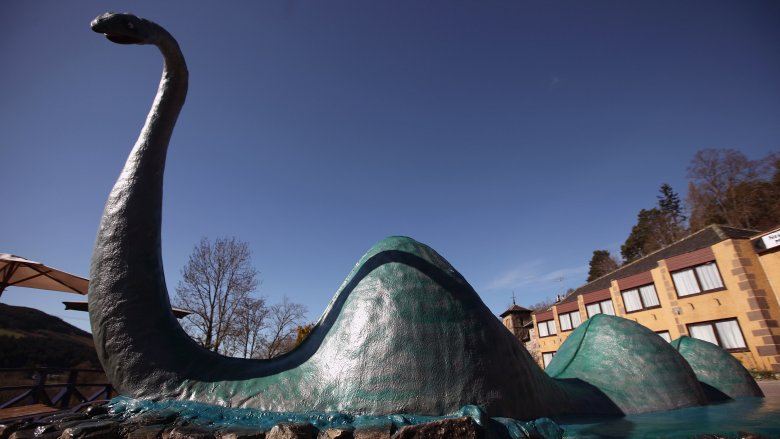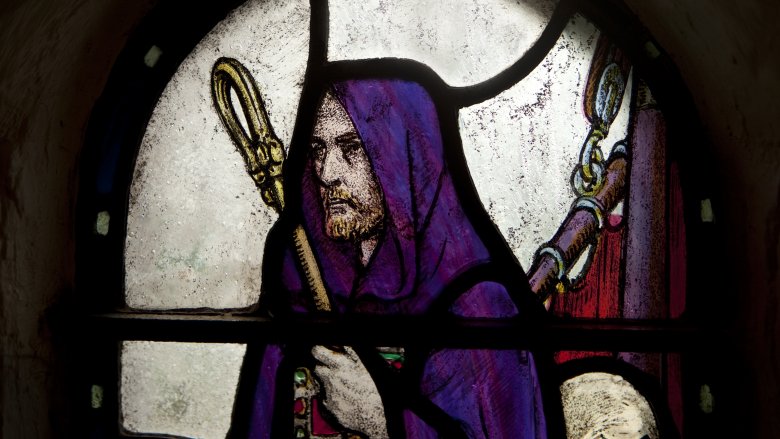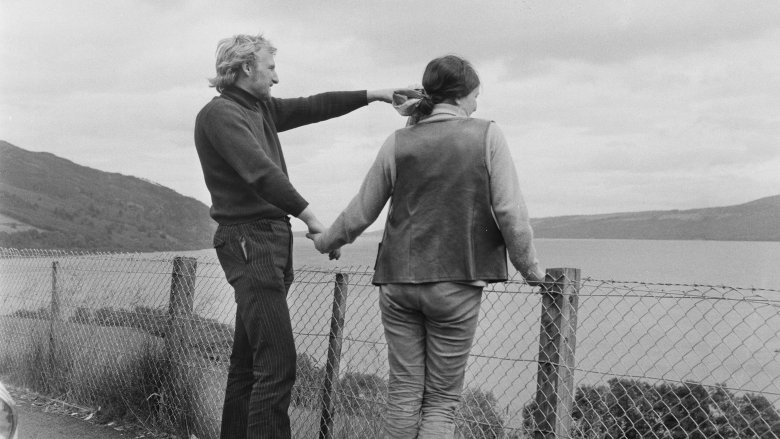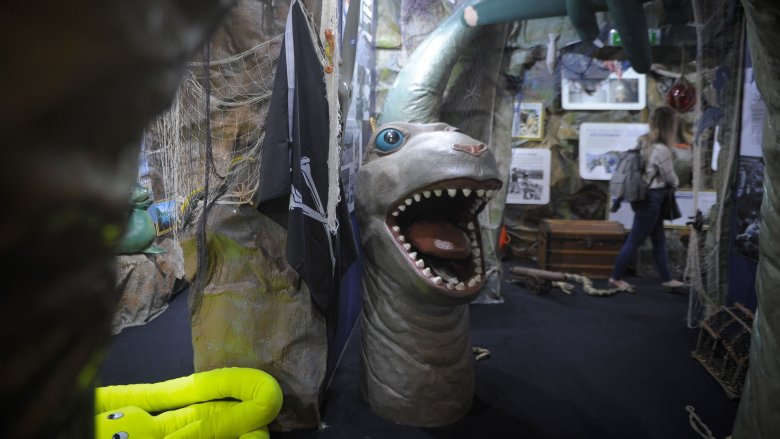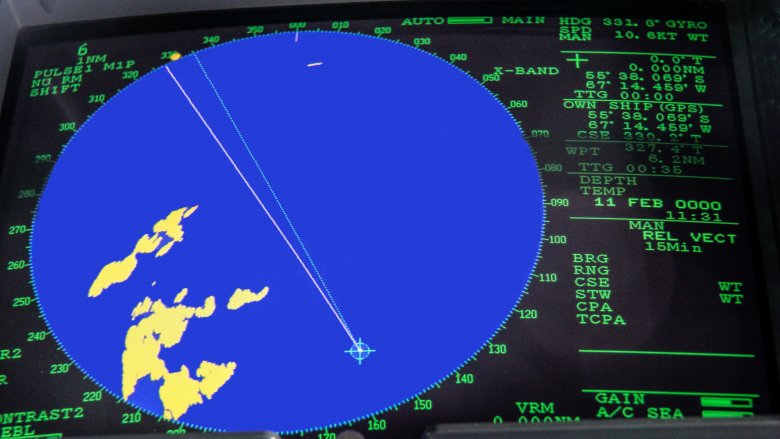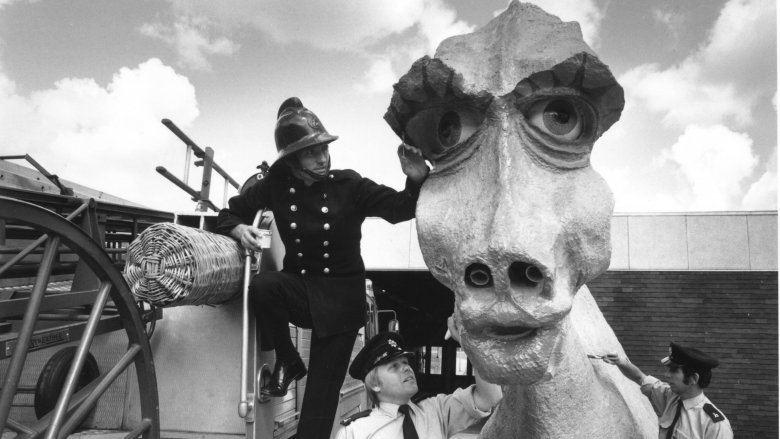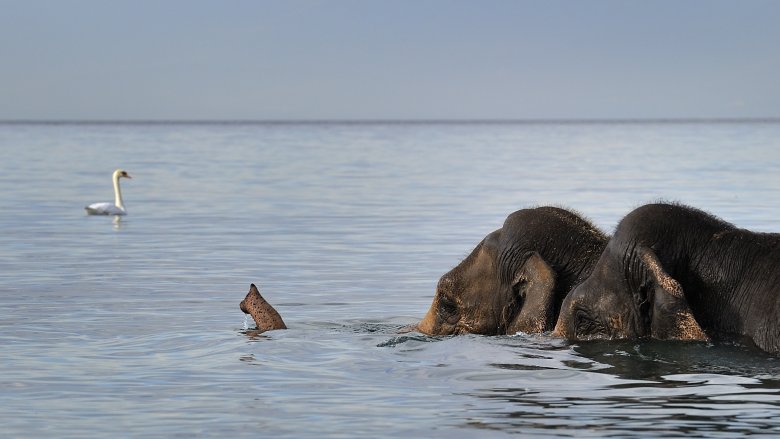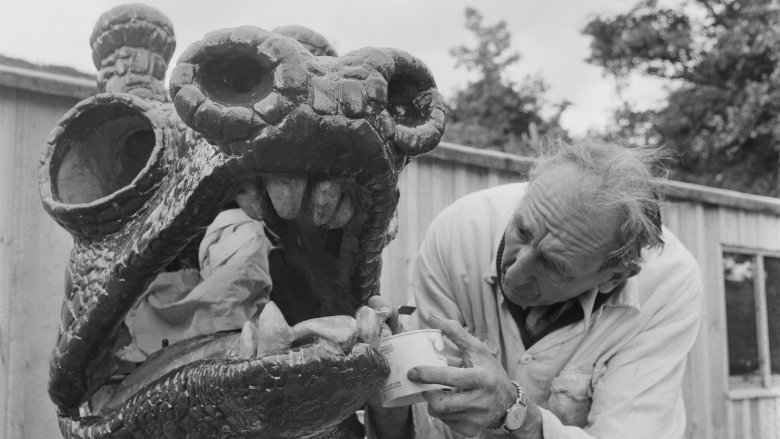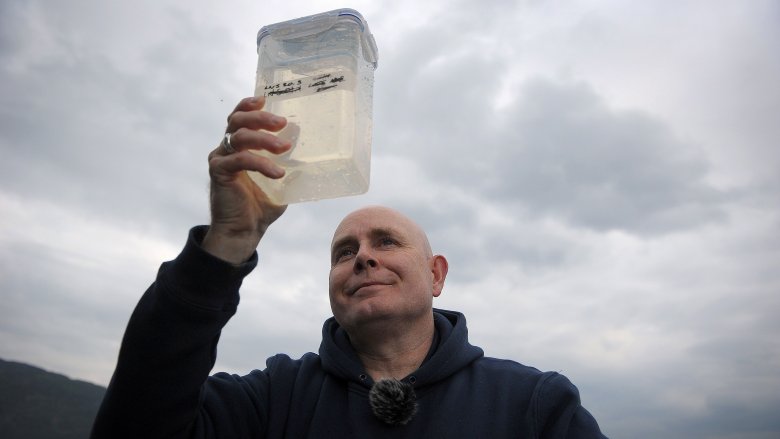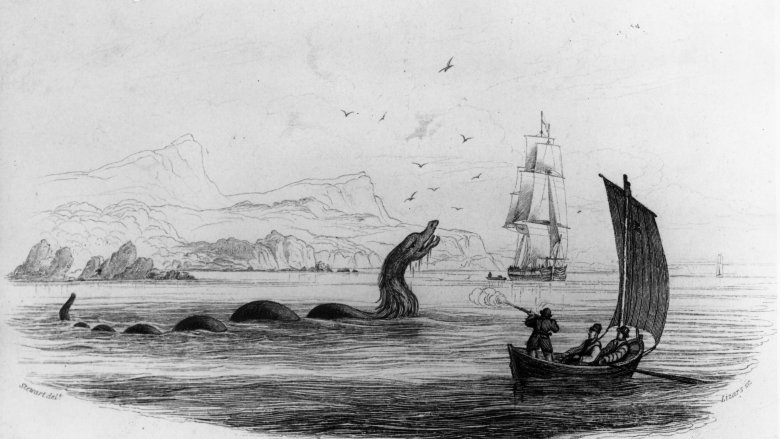The Truth About The Loch Ness Monster
Human beings have a fascination with the unknown and the fantastic. Reality got routine at some point in our history, possibly when accounting was invented, but the mysterious and the different has always kept us interested. Whether it's aliens or ghosts or Bigfoot, to think that there's some unknown thing out there that flies in the face of what science tells us is really kind of enticing. It's scary, but we like to be scared. That's why horror movies and roller coasters are so much fun. We want to encounter scary, new things. We want a monster to be real, especially if it's mostly docile and a fun tourist attraction.
Scotland's Loch Ness Monster has been capturing imaginations for years. A mysterious sea beast or a dinosaur species that somehow survived all these years is just a super fun idea. For most of us it's not scary in a life-threatening way. It's a persistent rumor, a juicy piece of gossip that you'd love to confirm. But what is the truth? Where did this thing supposedly come from, and why has it become so popular, and so fascinating? There's probably more to the Loch Ness Monster than you realize.
The first reference to the monster is 1,500 years old
You probably don't remember exactly when you first heard of the Loch Ness Monster. That's fine! These urban legends and myths just seem to be. But everything starts somewhere, and Nessie's beginning dates back much further than you might imagine.
The first known reference to the monster is not from this century or even the last century. The biography of St. Columba, the Irish missionary who introduced Christianity to Scotland, makes reference to a creature dating back to the year 565 A.D., according to History. In that story, Columba was on his way to visit the king of the Picts when he made a detour by the loch to see a monster that had been eating locals. The life of a missionary was pretty intense.
Did Columba find the beast? He sure did. Remember, this is part of his biography. Columba came upon the beast trying to eat a man and commanded it, in the name of God, to return to the loch. Being a God-fearing monster, it did as it was told, never to harm anyone again. In fairness, none of the modern sightings of the monster involve it eating anyone, so it's possible Columba's order stuck.
The first modern sighting was in 1933
The modern world's interest in the monster can be traced back to 1933. On May 2 of that year, the Inverness Courier, a local newspaper, ran a story. In the story, a couple claimed to have seen "an enormous animal rolling and plunging" on the surface of the lake, according to History. At the end of the day, people are the same now as they always were, and the idea of an enormous mystery beast where none should exist is just too enticing. The paper opted to call the unknown creature a monster, and soon after publication another couple claimed to have also seen a creature, this time on land. That was all it took to capture imaginations. Considering how many people claim to see Bigfoot or UFOs, it's no surprise.
The original Courier article actually acknowledges right away that the monster is not new — that the "water kelpie" as some called it, had been a myth around those parts for generations. But on that day, a well-known businessman and his university-educated wife had seen the creature. No longer was this a silly, backwoods myth told by unreliable bumpkin narrators. This was a story with a respectable pedigree, related by respectable people. That's how it leaped from fantasy into the actual news, gaining legitimacy and spawning nearly 100 years of fascination.
The most famous Nessie photo turned out to be a hoax
Everyone who has ever hunted a monster has wanted the same thing — proof. This was what drove Fox Mulder in The X-Files. The truth is out there, if you can find it. So everyone who ever believed in Bigfoot, leprechauns, ghosts, or aliens has tried to prove the things were real. And what's the simplest, easiest way to prove something? See it with your own eyes. People needed photos. On April 19, 1934, respected British surgeon Colonel Robert Wilson gave the world a photo of the Loch Ness Monster.
Depicting a long-necked creature mostly immersed in the water, the "surgeon's photo" is simply iconic. It resembles a plesiosaur, basically a long-necked aquatic reptile with a small head and fins. It set the standard for what people believe the Loch Ness Monster looked like and stood for years as the greatest proof of the beast's existence.
In 1994, a man named Christian Spurling made a deathbed confession. He, along with his stepfather Marmaduke Wetherell, who had been outed as a Loch Ness Monster hoaxer before the famous photo, faked the whole thing. Spurling's stepfather had the idea, Spurling created a small model of a serpentine beast, and Wilson would be the "credible" witness who saw the creature firsthand. It had all been a lie, revenge for Wetherell's outing as a fraud.
It's a multimillion-dollar tourist attraction for Scotland
Tourism is an important part of the livelihood of any town or country. You want people coming to visit and bringing their wallets with them. For a lot of smaller places that don't have the massive draws of a world-class city like London or Tokyo, that means finding a reliable gimmick. According to the BBC, Scottish tourism overall is worth about $14.5 billion U.S. That's a heck of a lot of people, and a good number of them may be heading to the loch. The potential to grab a piece of that big slice of pie is why Loch Ness Monstering has become its very own industry.
The BBC dug into the Loch Ness tourism industry in 2012. At that time, a million people per year were heading to the Loch Ness area, adding about $33 million to the local economy. Around 85 percent of those people were coming specifically because of the monster. Real or not, that thing is a cash cow. With places like Nessie Land offering cruises and presentations on the monster, and of course a gift shop, there are plenty of places to drop a few dollars monster hunting on vacation.
Operation Deepscan brought science to Loch Ness
Modern technology has made searching large bodies of water much easier than in the past. If you're hunting for a downed plane or ship, or even just looking for fish, sonar is what you need. In simple terms, sonar just bounces sound off whatever may be in the water and then uses the echoes that bounce back to map whatever may be down there. Seems like the perfect plan for hunting a large sea beast, right?
Operation Deepscan was the largest undertaking of its kind, meant to end the mystery of Loch Ness once and for all. Two dozen vessels scanned the loch with sonar for three days. In total they covered 60 percent of the loch's area, but it was too difficult to map areas closer to shore.
The first day of the search stirred excitement when scans discovered several large objects beneath the surface. However, subsequent scans found nothing in the same spot. Some suggested the scans were picking up seals, according to The Telegraph. You can never trust a seal.
The BBC says it doesn't exist
If you want a job done right, you have to be thorough, and that's what the BBC planned to do when they went searching for the Loch Ness Monster back in 2003. Using satellite navigation and extensive sonar, they covered the entire massive lake from top to bottom in search of anything even slightly anomalous. What did they discover? Nothing.
Using 600 sonar beams and guided by an understanding of how modern reptiles like crocodiles and turtles behave, the BBC team mapped every part of the loch. They were able to discover a small buoy below the surface, and map the walls of the loch, but there was no sign of any unusual life. The data they got was clear and showed the flat bottom of the loch as well as smooth, steep walls. Given the lack of anything even slightly mysterious, the researchers were forced to conclude there was no truth to the story of the monster. It's just a myth.
In a final test to show just how easy it would be for people to make up the monster story, even unintentionally, the team hid a section of fence in the water and raised it in front of a busload of tourists. When asked to draw what they had seen, most people drew a fence. Some people inexplicably produced a rolling, serpentine shape. You can't trust the human eye sometimes.
There are many possibilities for what the monster could be
The thing about any mystery is that, once people get involved in trying to solve it, you'll get all kinds of competing theories. The Loch Ness Monster is no different. While some people readily accept that there must be some cryptozoological anomaly living in the waters of the loch, other people aren't so sure.
Jeremy Wade, the host of the show River Monsters, suggested the monster was actually a Greenland shark. The Greenland shark can grow to 18 feet in length and has extremely small pectoral fins, giving it an overall serpentine appearance. It's also known to eat anything that gets close to it.
Steve Feltham, Guinness record holder for maintaining the longest continuous monster hunting vigil of the loch, has been looking for Nessie for 24 years. After all that time, Feltham has made a determination about the nature of the monster — he thinks it's a catfish, according to The Scotsman. Specifically a Wels catfish, able to grow up to 13 feet in length, introduced to the lake during the Victorian era for sport fishing.
One of the most bizarre theories about Nessie was that it was actually an elephant. National Geographic reported that paleontologist Neil Clark came up with the theory after seeing Indian elephants going for a swim. Traveling circuses used the road alongside the loch for travel, perhaps letting the elephants stop to swim. Who knew Nessie was potentially so diverse?
People keep hoaxing stories about the monster
Literally hundreds of people have claimed to have seen the Loch Ness Monster over the years and there's still no definitive proof it exists. Now that could just be the result of some monumentally bad luck — maybe all those people saw something when they were alone that no one else has been able to confirm. Or, just as likely, all those people did not see a monster. Some may have been mistaken, some may have been duped, and others may have been straight-up lying. We have several proven cases in the "lying" category already.
In one of them, an Italian journalist named Francesco Gasparini once claimed he had been working at a British newspaper in 1933 when he ran across a fairly boring story of a strange fish being seen in Loch Ness. Gasparini said to make the story interesting he made up the entire original Loch Ness Monster sighting. The couple who claimed to have witnessed the creature were all figments of his imagination, which he admitted to in 1959, according to the Irish Times. Now whether that's true is also debated by believers, but it casts even more doubt over the entire story.
DNA testing hopes to prove whether it exists or not
Photos of a monster are a great start for proving the monster exists, but in modern times a photo isn't worth quite what it used to be. If you're skilled enough with Photoshop you could make a picture of the Loch Ness Monster sitting down to tea with the Queen of England on Mars. Luckily, science offers up better methods of proving things. One of those is DNA testing.
A scientist based in New Zealand, professor Neil Gemmel, mounted an expedition in 2018 to test the waters of Loch Ness for biodiversity. Using DNA sampling techniques, the team would be able to take water samples and then test to see what all lives in the lake. Gemmel didn't have any expectations of finding a monster, but whatever there is to find he should be able to figure out based on the samples they're going to take. He seems a little more excited for discovering new bacteria when describing his project to The Guardian, and acknowledges the monster is just the hook to gain interest, but he's at least open to the idea that he may discover some answers. That could include no evidence of the monster at all, definitive proof there is some kind of giant reptile, or maybe just evidence of some large eels or other fish that could have been mistaken for the monster over the years.
It's not the only one
Arguably one of the most interesting things about the Loch Ness Monster is how not unique it actually is. Lake monsters are extremely common in folklore, and it just so happened that Nessie became the iconic one. Likely the surgeon's photo is the reason the monster in Scotland is the gold standard, but many other lakes boast their own mysterious creatures from the depths.
Over in Utah and Idaho, there's more than one creature alleged to be residing in Bear Lake. Pioneer settlers claimed to have seen something in the lake as early as 1868, according to Deseret News.
Canada's Lake Okanagan is the reputed home of the Ogopogo. Like Loch Ness, the Ogopogo is a long serpent creature. Still in Canada but a little further east, the Manipogo is a lake monster supposedly found in the waters of Lake Manitoba. Like the other creatures, it's serpentine and unusually large. It too has been documented in photo form, albeit an extremely vague one from 1962, as shown in the Winnipeg Sun.
Lest you think hunting for these creatures is a silly waste of time, it's worth noting that Turkey has its own beast, the Lake Van Monster, and when teams went hunting for it they discovered a 3,000-year-old castle under the lake. No monster, but at least it's something old and interesting.
